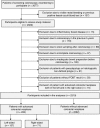Sensitivity of immunochemical faecal occult blood testing for detecting left- vs right-sided colorectal neoplasia
- PMID: 21559011
- PMCID: PMC3111170
- DOI: 10.1038/bjc.2011.160
Sensitivity of immunochemical faecal occult blood testing for detecting left- vs right-sided colorectal neoplasia
Abstract
Background: Faecal occult blood tests (FOBTs) are used for colorectal cancer (CRC) screening. We aimed to assess the sensitivity of an immunochemical FOBT for detecting advanced colorectal neoplasia in the left vs the right colon and to explore reasons for potential differences in site-specific test performance.
Methods: We prospectively measured faecal occult blood levels by a quantitative immunochemical FOBT (RIDASCREEN) in 2310 average-risk subjects undergoing screening colonoscopy. We compared diagnostic performance for subjects with left- vs right-sided advanced neoplasia, as well as patient characteristics and adenoma characteristics that have been suggested to impact faecal haemoglobin levels.
Results: Sensitivities for subjects with left- vs right-sided advanced neoplasia were 33% (95% confidence interval (CI), 26-41%) and 20% (CI, 11-31%) (P=0.04) at a specificity of 95% (overall sensitivity: 29%) and the areas under the receiver-operating characteristics curve were 0.71 (CI, 0.69-0.72) and 0.60 (CI, 0.58-0.63), respectively. Pedunculated shape was strikingly more common in participants with left- vs right-sided advanced neoplasia (47% vs 14%). In logistic regression analyses adjusted for site, pedunculated shape was statistically significantly associated with test sensitivity (P=0.04).
Conclusions: The immunochemical FOBT in our study was more sensitive for detecting subjects with left- vs right-sided advanced colorectal neoplasia. Our findings may stimulate further diagnostic research in the field as well as modelling analyses to estimate the potential effect of site-specific test performance on the effectiveness of annual or biennial FOBT-based screening programmes, in particular with respect to protection from right-sided CRC.
Figures



References
-
- Ahlquist DA, Sargent DJ, Loprinzi CL, Levin TR, Rex DK, Ahnen DJ, Knigge K, Lance MP, Burgart LJ, Hamilton SR, Allison JE, Lawson MJ, Devens ME, Harrington JJ, Hillman SL (2008) Stool DNA and occult blood testing for screen detection of colorectal neoplasia. Ann Intern Med 149: 441–450 - PMC - PubMed
-
- Baxter NN, Goldwasser MA, Paszat LF, Saskin R, Urbach DR, Rabeneck L (2009) Association of colonoscopy and death from colorectal cancer: a population-based, case-control study. Ann Intern Med 150: 1–8 - PubMed
-
- Blatt LJ (1961) Polyps of the colon and rectum: incidence and distribution. Dis Colon Rectum 4: 277–282
-
- Brenner H, Chang-Claude J, Seiler CM, Stürmer T, Hoffmeister M (2007) Potential for colorectal cancer prevention of sigmoidoscopy versus colonoscopy: population-based case-control study. Cancer Epidemiol Biomarkers Prev 16: 494–499 - PubMed
-
- Brenner H, Haug U, Hundt S (2010a) Inter-test agreement and quantitative cross-validation of immunochromatographical fecal occult blood tests. Int J Cancer 127: 1643–1649 - PubMed
Publication types
MeSH terms
LinkOut - more resources
Full Text Sources
Medical

